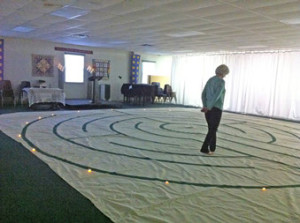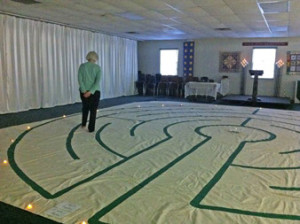Many traditions include the use of a labyrinth in their spiritual practices. We are fortunate at UUCSV to have our very own labyrinth which is currently open by appointment, due to COVID protocols. There is no charge.
Why Walk the Labyrinth?
A labyrinth, at first, looks like a map on the floor: The lines represent the “walls,” while the spaces between them are paths. The paths are made up of circuits, like rings, that fold back on themselves, change direction and bring you close, and then away from, the center. Each time you enter a different circuit, you turn 180 degrees. As you change direction, you shift your awareness from right brain to left brain which induces more receptive states of consciousness. Unlike a maze—which can confuse and challenge you with wrong turns and dead ends—a labyrinth has only one path, which is both the way in and the way out. Eventually you reach the center, a place for meditation, prayer or reflection. What you discover, receive or imagine there can be absorbed and integrated on your walk out. The labyrinth is a metaphor for spiritual and personal transformation.
 The entrance and surrounding “wall” mark the start of a journey, one that takes you away from our normal, everyday life and leads you inward. The path inside the labyrinth twists and turns; just as you seem to be reaching the center, the path takes you away from it. Like the spiritual path, the labyrinthine path can sometimes seem frustrating and difficult. You may even feel it is not worth the effort. But you do know that eventually you will reach the center.
The entrance and surrounding “wall” mark the start of a journey, one that takes you away from our normal, everyday life and leads you inward. The path inside the labyrinth twists and turns; just as you seem to be reaching the center, the path takes you away from it. Like the spiritual path, the labyrinthine path can sometimes seem frustrating and difficult. You may even feel it is not worth the effort. But you do know that eventually you will reach the center.
Each person’s walk is a unique experience. How you walk is your individual choice. Some people use the walk for clearing the mind and centering themselves. Others enter with a question or concern. Your time in the center can be used for receiving, reflecting, meditating or praying, as well as for discovering your own sacred inner space. The return walk outward provides time for integrating what you have received. Your walk can be a healing and very profound experience, or it can simply be a stroll. Each time is different. There is a cumulative effect of working with labyrinths over time.
If You Have Never Walked a Labyrinth Before, You Might Appreciate a Few Suggestions
1. First, don’t be in a hurry. Your walk can be as quick or as long as you like. There are no timing rules.
2. Center yourself before you enter the labyrinth: take a deep breath in and a long exhale out.
3. Be open to whatever the labyrinth may bring. Decide what you want to hold in your mind. It may be something
as simple as reciting a mantra for peace, such as “May peace prevail in the world.” or just repeating the word “peace.”
4. Or set your intention on whatever problem or issue that you may want to ponder as you proceed.
5. Take notice how the twists and turns make you feel, all the while holding to your intention.
6. You may decide to stop somewhere along the way. Some of the turning points are large enough for you to
step into and allow others to pass.
7. Don’t feel forced to move at someone else’s speed. This is your time.
8. When you finally get to the center, let yourself linger. You may choose to sit for a while, and just be still.
 Don’t expect an immediate, life-changing experience. If you enter with an open mind and heart, though, you may be surprised at what you learn. What is required is that you give yourself time to be. When you are ready to return to the world, begin the process back. It is likely that you will encounter others on their way in. There is enough space for both of you. If you are not walking the labyrinth alone, you could be walking side by side with someone, then separate and even appear to be moving in opposite directions. As in life, we travel with some for a while, and then we are off on our own. Ultimately, it is our own path that we must take. A labyrinth may be used for as many purposes as there are people who use it. Let your imagination run free, and you may find that using it repeatedly provides you with a source of inspiration and balance.
Don’t expect an immediate, life-changing experience. If you enter with an open mind and heart, though, you may be surprised at what you learn. What is required is that you give yourself time to be. When you are ready to return to the world, begin the process back. It is likely that you will encounter others on their way in. There is enough space for both of you. If you are not walking the labyrinth alone, you could be walking side by side with someone, then separate and even appear to be moving in opposite directions. As in life, we travel with some for a while, and then we are off on our own. Ultimately, it is our own path that we must take. A labyrinth may be used for as many purposes as there are people who use it. Let your imagination run free, and you may find that using it repeatedly provides you with a source of inspiration and balance.
More About A Labyrinth:
The labyrinth is found in many cultures, usually as a symbol of spiritual journey and transformation.
The first known labyrinth appeared in Crete around 3,000 BCE. Its exact meaning and use are unknown, but researchers speculate that it was part of a sacred Greek dance, traced on the ground for the dancers to follow.
In Europe during the Crusades, the labyrinth symbolized the spiritual pilgrimage to the Holy Land. For the Native American Hopi people, the labyrinth symbolizes death, rebirth and a return to Mother Earth.
The labyrinth at UUCSV is a six-circuit canvas labyrinth, loosely based on the medieval model at Chartres Cathedral. It has a 24” wide walking path with four inch “walls”. The center is encircled by a lotus leaf pattern, symbol of purity and divine regeneration. As we make our way to the center, and then return, we may find some respite from the everyday “busyness” of life. The hope is that you can walk out of the labyrinth refreshed to face whatever life has to offer.
Contact: Lenore Askew at pandora@ptd.net
